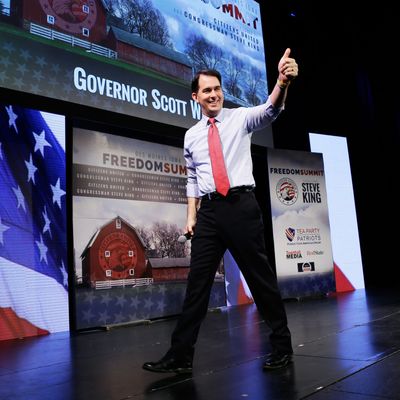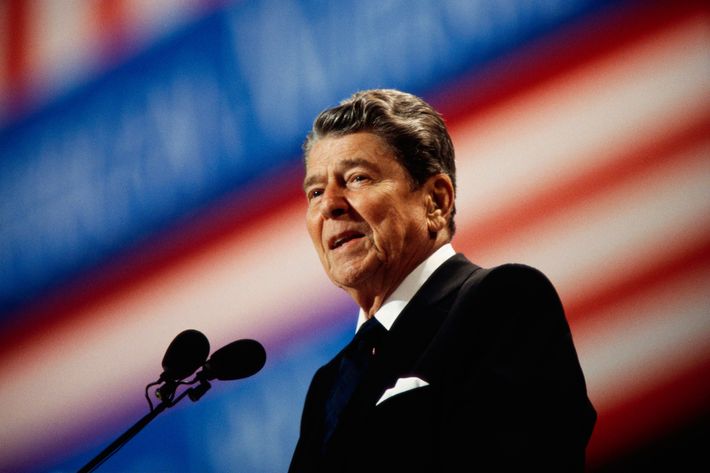
At the 2013 Reagan Day Dinner, Wisconsin governor Scott Walker, standing in front of an oil painting of Ronald Reagan bathed in holy light shining down on his head, began to recount his connections to the former president. He mentioned that his own wedding was held on the day of Reagan’s birth, and also that his recall election coincided with the anniversary of “the day he was born into eternal life, the day he passed.” Walker then began to recount his visit to the Reagan Library, in suitably awestruck tones. At that point the story began to take on even more overtly religious overtones.
As Walker recounted for his audience, the library’s curator came to him holding a sacred relic: the Reagan Bible, the very one the Gipper himself had sworn the oath of office upon. “And they brought over a pair of white gloves for me and [the curator] said, ‘No one has touched this since President Reagan,’ recalled Walker, ‘It is his mother’s Bible that he took the oath of office on. Mrs. Reagan would like you to hold and take a picture with it.’”
Jud Lounsbury reported recently that Walker’s version of the Reagan Bible story is not exactly accurate. Walker told his audience that the presentation of the Reagan Bible was “unbeknownst to me,” heavily implying that Mrs. Reagan herself had selected him for this unprecedented honor. In fact, according to the Reagan Library curator, Walker had called ahead and asked for the Bible. But the interesting thing about the story is not its historical fealty. It is that Walker wants to tell it at all.
Fifteen years ago, I wrote an article about the Republican Party’s Reagan cult. Within the Party, Reaganism is truth, and truth is Reaganism. Republicans may debate the meaning of Reaganism, presenting dueling interpretations to associate their own ideas with his, but challenging the actual wisdom of a thing Reagan did is unthinkable. Everything Reagan thought or did was presumptively correct, even the things that contradict the other things he did.
In practical terms, the Reagan cult is largely (though not entirely) a propaganda vehicle for the anti-tax movement, which has — more forcefully than any other constituency within the Party — defined its ideas as synonymous with Reagan’s. In reality, Reagan veered wildly out of step with anti-tax orthodoxy. It is true that, in 1981, he supported a large program of regressive, debt-financed tax cuts, which remains the heart of the Party’s domestic program. But Reagan’s administration still contained plenty of old-line fiscal conservatives who had come of age before the relatively recent rise of supply-side economics. They thought Reagan’s tax cuts were too large and too tilted toward the rich, and supported a major tax increase in 1982 to stanch the loss of revenue, and a progressive tax reform in 1986. (While the 1986 tax reform lowered nominal tax rates, it wiped out the preference for capital gains and increased effective tax rates on the rich, making it totally anathema to modern-day Republicans, whose tax proposals invariably reduce the tax burden on the rich.)
But anti-tax activists have defined Reaganism as an absolutist fixation with lower tax rates. The Ronald Reagan Legacy Project, a frantic effort to name as many things as possible after the 40th president, is actually housed within Americans for Tax Reform, the Washington lobby that pressures Republicans to sign a pledge to disavow any revenue increase, however tiny, under any circumstances. As Walker has figured out, Reagan iconography does not depend upon literal truth.
Predictably, the efforts by “reform conservatives” to alter their party’s domestic strategy quickly devolved into a liturgical contest of Reaganite purity. (Or, as I like to call such arguments, a Reagan-Off.) The reformists believe that the Party’s obsession with cutting taxes for the rich has grown into an unaffordable electoral liability. They accept the premise that Reagan’s agenda represented a perfectly correct response to the problems of his time, but question whether they represent the perfect response to every problem of every time. “Room to Grow,” the reformist manifesto, puts it delicately: “The truth is that many conservative policies worked in the 1980s — but conditions have changed, often dramatically, and conservatives haven’t changed sufficiently with them.”
The supply-siders have cast the reformists as heretics. Wall Street Journal columnist Kimberley Strassel denounced “a new wing of the conservative movement that has taken to arguing that the whole free-market, supply-side, Reaganesque agenda is passé.” Daniel Mitchell argues, also in the Journal, “The supply-siders want to replicate the success of Reaganomics with lower marginal tax rates. But there’s also a camp who call themselves ‘reform conservatives’ who want income tax credits or payroll tax cuts explicitly for the purpose of reducing tax liabilities for middle-class parents.”

And as for the possibility that a 35-year-old platform might not perfectly suit the needs of the contemporary world, Jeffrey Lord suggests that Reagan himself anticipated the objection and rejected it. “Reagan rebutted the ‘times change’ business by saying that ‘history comes and goes’ but that ‘principles endure,’” he argues, “He was constantly amused by people who talked the ‘times change’ happy talk thinking that they had just re-invented the wheel.”
Of course, the reform conservatives have hardly ceded the word of Reagan to their foes. Instead they have insisted that they represent his authentic word. Henry Olsen has presented the reform conservatives as “heirs of the Reagan tradition”:
In 1977, when conservatism was at its political nadir, Ronald Reagan gave a bold, optimistic speech at the fourth annual CPAC convention. “A New Republican Party” was effectively Reagan’s blueprint for victory in 1980, and it rested on Reagan’s political touchstone, respect and admiration for the common American. Last week, two young heirs of the Reagan tradition offered their ideas of what a new conservatism might look like.
Likewise, Quin Hillyer (beginning with a story from the 1980 Republican convention, at which he “served as a page”) casts the reform conservative platform as the real Reaganism. “Like the program of today’s erstwhile reformers, Reagan’s agenda always was worker-centered and family-first,” he writes. “Reagan’s agenda always was pragmatic rather than rigidly ideological — and Reagan himself, like today’s reformers, expressed far more affinity for ‘Main Street’ than for big corporations.”
You can understand why the reform conservatives presented their case this way — winning a Reagan-Off is the only way to win an argument within the Party. Yet the form of the debate helps explain why the reformists were so badly crushed. The history used by the supply-siders may be inaccurate, but the fanaticism with which they purvey it is real. And in a contest of theological devotion, feigned fanaticism will usually lose out to the genuine kind.






























